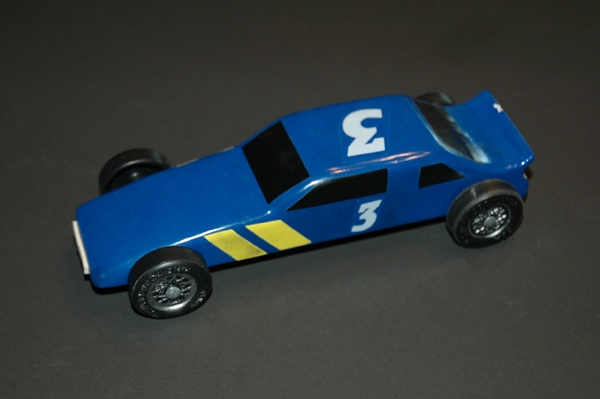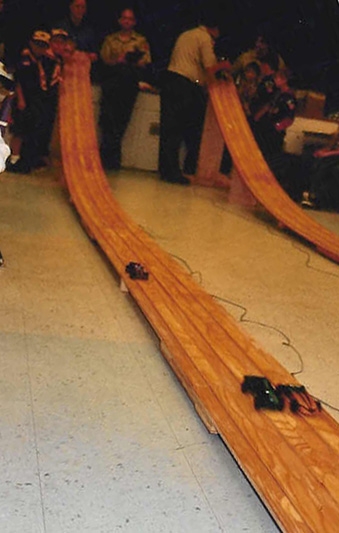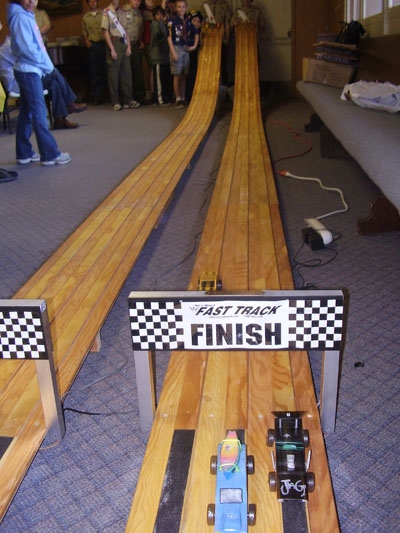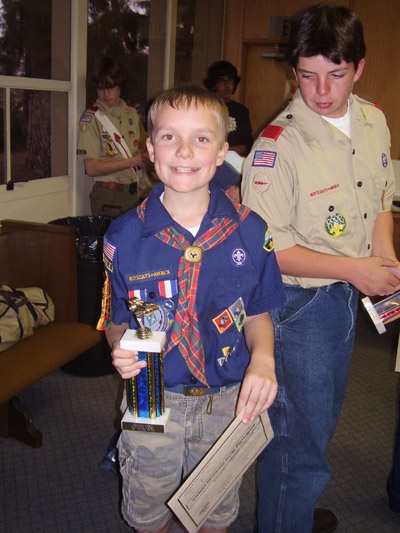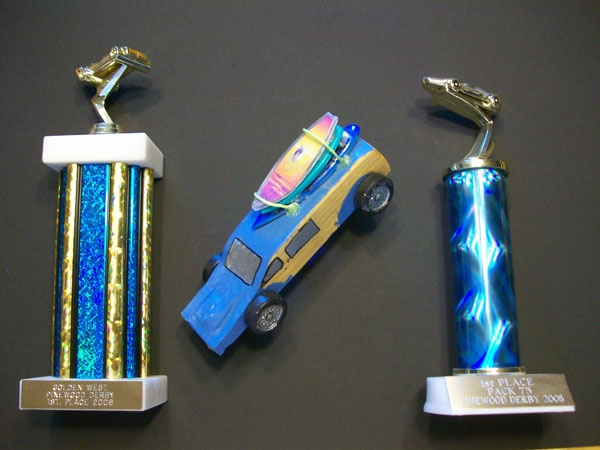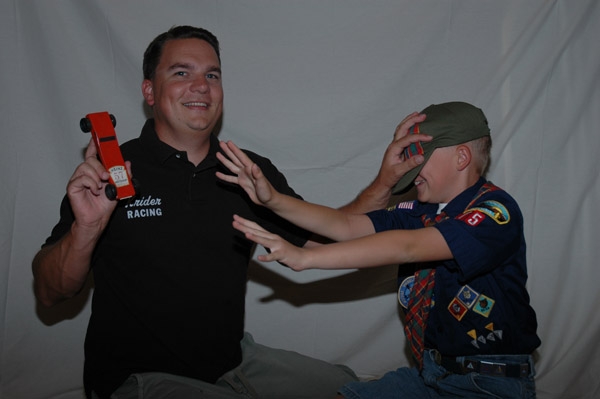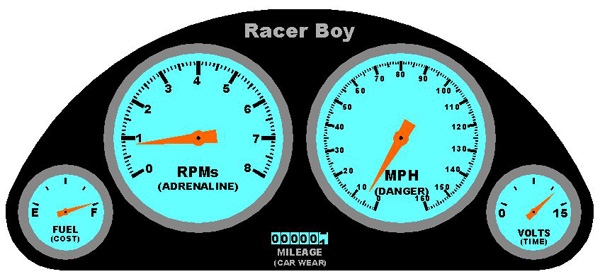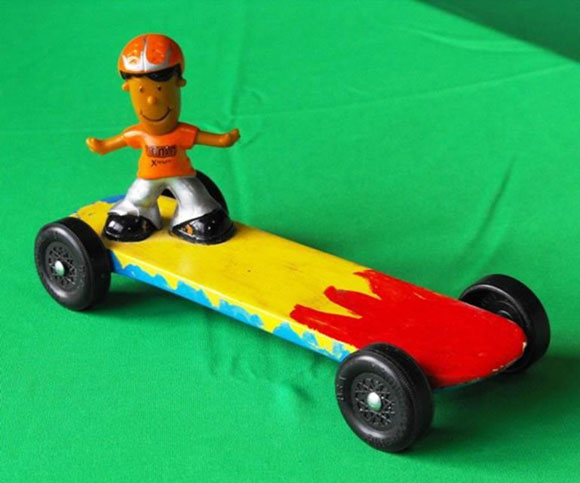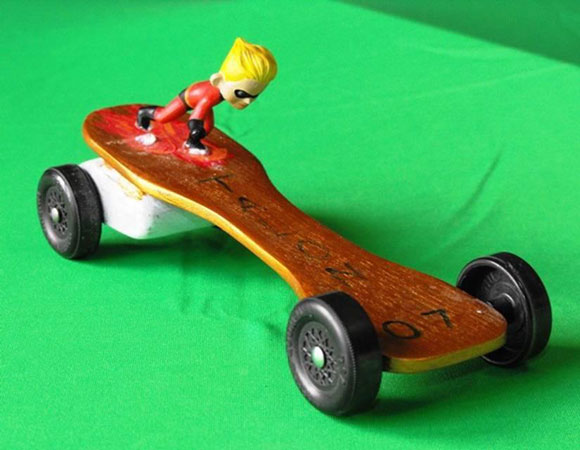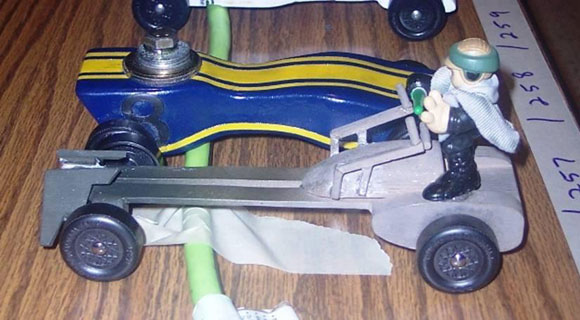– Feature Article – Your First Taste of Victory or Defeat
– Pinewood Derby Car Showcase
– Memory – Not a Bad Day
– Q&A
Racer Boy: Pinewood Derby – Your First Taste of Victory or Defeat
By Rob Krider
Most of us gearheads experienced our first competitive car race in the pinewood derby. A seven inch long piece of wood, four nails, four plastic wheels and a sloped track – that’s it. Gravity is the only motor in this race. At first glance it seems like there isn’t much to the pinewood derby. However, after getting your rear kicked your first year you realize that a pinewood derby car can be as complicated as any real racecar. Aerodynamics, rolling friction, center of mass, weight, alignment, lane choice, there are all sorts of things that can make the car roll down the track or get stuck halfway down the hill. Of course, as a seven year old kid you have no idea how to change the center mass of a pinewood derby car, that’s where dad comes along.
The Cost
An official Boy Scouts of America Pinewood Derby kit is about five bucks. This is the first and last time for the rest of your life, that racing will only cost you five bucks. A can of spray paint and some stickers may rack up a few more coins at the local hobby shop, but all in all you can build one of these racers for less than it costs to go to McDonalds and try to stop your heart.
Sanctioning Body
The Boy Scouts of America started this craze in Manhattan Beach, CA back in 1953 and still hold the reigns on it. Other groups like Awana also run pinewood derby events. It’s a cool thing for the kids and easy for clubs to set up. All you need is a sloped track for the cars to roll down. Some tracks are more high tech and have computer timing and scoring.
The High
Because you aren’t actually driving these cars at high speeds, obviously there isn’t much adrenaline rush in pinewood derby racing. But, as the cars roll down the wooden track there is a bit of a high while you’re waiting to see if your car comes in first. In fact, most people aren’t breathing as the cars are in motion. If you win, you are loving life, if you lose, you want to go home and kick the dog.
Car Wear
If the pinewood derby car is built tough it can last the entire event. Most cars lose a wheel or two during the day (easily fixed by pushing the nail and wheel back into the chassis). The hardest part on the cars isn’t the racing, it’s the thirty or forty eight year old kids grabbing, drooling on, and dropping the car over and over again between rounds of racing (ruining the perfect alignment you worked so hard on).
Your Day
After a solid week of making sawdust in the garage and trying to turn a wooden block into something that resembles a car you head out to the pinewood derby race. The cars are weighed in (you can make minor adjustments here) and inspected to make sure they are using only Boy Scout supplied components (no cheater axles or tricked out wheels). Then the cars go to impound. The cars are put onto the track and raced three at a time (depending on the width of the track, I’ve seen some ten lanes wide). The race consists of a lever being pulled and the cars all being released to roll down the track. First one to the finish line is the winner. Think of it as drag racing a two by four. The racing is an elimination format and during the event, the winners keep advancing while the losers head back to the trailer (or the tool box, in this case). Finally it will come down to two cars. They will race in a double elimination format (swapping lanes so there is no track advantage). The final car is crowned the champion.
The People
Racers are comprised of Cub Scouts. These are good old fashioned honest young kids working hard for an achievement patch. If you want to compete you’ll need to be a kid between the ages of 5 and 12 years old. So, either invent a time machine and go back to race, or do what I did, get married and get yourself a son. Then you’ll have to sit around impatiently until the kid is old enough to become a Cub Scout. Once he finally hits that magical age, get yourself a drill press, a Dremel, some sand paper and get to work. I mean, get to work, uh, letting your son build the car.
Glory
There is glory in the pinewood derby. Winners earn great looking trophies and move on to District Championships. At the Championships the kids get the chance to race against the best of the best. No, they don’t have Girl Scouts as trophy girls.
Oh, You Want To Win, Do Ya?
Just like in real racing, who your daddy is, can make all the difference in your on track success (just ask Dale Jr.) If your dad was a carpenter or a racecar driver, chances are you won your first pinewood derby. For the rest of you (who got your rears kicked by the kid whose dad was a racecar driving carpenter) here is how you win the pinewood derby. Weight is your friend. You want that car to weigh in at 5.0 ounces exactly (we bring our cars to the event heavy and then use a small drill bit to take out weight from the front end until the scale tips 5.04 ounces on the money – which rounds down to 5.0 ounces on the scale readout). Tungsten is a very dense metal and is great for placing weight in the car (use epoxy – anything else will let the weight fall out during the races). The center mass of the car should be as far back as possible to give the car a little extra boost of potential energy converted to kinetic energy as the car transitions from the slope of the track to the flat (Don’t believe me? Go read a physics book).
The wheels need to be as round as possible which can be done by spinning the wheel on a drill press and using some fine sandpaper. The nails, which are the axles, have small burs on them that actually slow the wheels down. The nails need to filed down to a perfect roundness and polished to a mirror image (this is allowed in the rules). A longer wheelbase makes the car more stable on the track. The wheels and axles should be aligned perfectly as they are placed in the car (use a tiny bit of super glue to set the axles and keep them from sliding out of the chassis). Rolling friction is not your friend so having one wheel off of the track (aligned higher in the chassis so the wheel doesn’t touch the ground) will cut your rolling resistance by 25%. Aerodynamics don’t play an enormous role in pinewood derby but building a car that looks like a sailboat with a huge sail on the roof isn’t helping matters. My son’s car had six coats of paint on it and was wet sanded between coats just for a little extra aerodynamic advantage.
If you really want to win, build a scale practice track and then construct ten cars (I’m serious). Race all of them against each other and the winner goes to the show. Every racer knows that testing and tuning is what really wins championships.
Racer Boy Gauge
Let’s review the Racer Boy gauge cluster here:
Fuel (Cost): The fuel gauge is near full because this is the cheapest racing on the planet.
RPMs (Adrenaline): The tachometer is at 800 RPMs because watching a piece of wood roll down a wooden track doesn’t really compare to sliding a car sideways at an autocross. However, you can get your adrenaline up by winning some races.
MPH (Danger): The speedometer is at 5 miles per hour because nobody has ever been killed racing a pinewood derby car. However, building the car, you can lose a finger messing around with the drill press.
Volts (Time): The volts gauge is over three quarters because this doesn’t take much time to race but you can spend over a week sanding and painting your little wooden car. Then again I’ve seen some kids and dads build the kit during tech inspection at the event (no, they didn’t win).
Mileage (Car Wear): The mileage is at just over one tenth of a mile because the track is only about forty feet long. As your car continues to win rounds, you’ll keep racing.
Checkered Flag
Kids can learn a lot about actual racing from participating in the pinewood derby. They can learn how preparation and a sorted car can bring home victory. They can also learn how nutty their dad is when he starts to go all Penske on the car and tries to build it for him. The important thing is to let the kids build the cars (or at least let them think they built them, anyway). See you at the track.
Originally published December 6th, 2009 on speedsportlife.com
Used by permission
Pinewood Derby Car Showcase
These three cars were made by Jim Brovont. Do you see the theme?
Surfer
This was the first car we ever built together. He was a Tiger scout and we were told that the upturned nose would get it disqualified at the race as being designed to give unfair advantage at the start gate. So we ditched the surfboard and designed Flash.
Flash
Flash went on to take first in his den, and 4th in the pack. The rear axle pod was hollowed out and filled with lead prior to painting.
Luke Skywalker
My son Talon is a huge Star Wars fan so the following year we built Luke riding a speeder bike. It was built with front wheel suspension, the nose fairing has a cross piece at the height of the original block belly for a “fair” start and to catch the timer sensor. Our track has a very fast spring loaded start gate so raised noses are really an insignificant advantage in my opinion. This car was 2nd in the Wolf den and made a good showing of itself at the District race as well.
Pinewood Derby Memory
Not a Bad Day
My youngest son, Owen, was in his first pinewood derby. He loves his big brother Jackson so much that while building our cars he said, “I want Bubby to win, but I would like to finish 2nd.” Jackson responded, “Well, maybe you can get in the top four.”
On race night Owen broke his big brother’s track Record on his very first run. Then, as Owen had predicted, Jackson finished in first, and Owen finished in 2nd, so both got to move on to the District Race.
On the day of the District Race, we arrived and went through tech, with an hour to spare. With two racers I wanted plenty of time to fix the cars if they did not pass. All was well.
Ten minutes after racing should have started (An hour and 10 minutes after passing inspection) more than forty cars (just shy of half the field) were called to the front. For various “new” reasons they would not be allowed to race. We had only twenty minutes to comply.
The issue with our cars was that the inside hub was coned and should have been flat or square. My boys were very upset – probably because their Dad was in a panic.
I knew I couldn’t get both of my son’s cars repaired in time. How do I choose which one? I couldn’t choose, so I started sanding the hubs flat. Miraculously the cars were finished in time and were able to race.
Both did well, but Owen, in his first District Race, came in 3rd. (The Dad that caused the forty plus cars to be re-worked came in 1st – funny, huh?).
That same day our family had planned to drive to Indianapolis to celebrate my birthday; so immediately after the race we drove to Indianapolis (40 minutes away) to celebrate.
Also, that day the Indiana State Museum was allowing people to race on a three-story,”World’s Fastest Track”. Wow! It was awesome! We allowed the boys to bring their cars and each “Racer” (not scouts) was allowed two runs. Then we would be off to dinner.
It was so much fun. Wow! Over 400 mph scale speed!
Upon trying to leave, we could not find our cars? Oh, no!
Someone finally said, “You know, the fastest twenty four cars raced all week are having a little runoff tonight. Have you checked the “Fastest 24” table?
So, we did and to our delight both boys’ cars made the “Top 24” fastest cars of the week.
I know that:
- no less than six states were represented,
- while going through tech inspection, other than me and my boys, the average age of the racers was 50,
- each had as many as twelve different cars in nicer cases then the Hope Diamond.
Anyway our day just got longer since we felt we had to allow the boys to participate in the runoff.
Well Jackson ended up getting bumped, 26th fastest. Then, Owen got to race. Owen came in 2nd on his first heat, 4th on his 2nd heat, then 1st on his 3rd and 4th.
Wow! He gets to keep racing! He’s in the top twelve.
He comes in 1st on his first heat. “No way!” say his parents.
He comes in 3rd on his 2nd heat. Okay more realistic.
Then 2nd place in both of his final two heats. Okay, that was fun now we can go eat dinner (7pm).
Oh my gosh! He made the “Final Four”. Are you kidding me? My wife and I are beside ourselves. Here is this teeny weenie six year old dancing and smiling, and the men are getting whooped by a kid barely 40 lbs. (No offense, but yes, many were engineers)
The “Final Four” race begins. Owen wins the first of four. Dad almost faints! In the end he comes in 3rd place overall (out of about 1,000 cars).
So, at the end of the day, a first year racer is driving home with two, 3rd place trophies.
Not a Bad Day!
Michael Onieal
Q&A
I have a set of the DerbyWorx RS wheels. The maximum weight on our Outlaw class is 10 ounces. Will these wheels handle that much weight? We have a two lane track and every car will compete twice against each other car; if 10 cars enter, each car will run a minimum of 20 races.
The outlaw wheels are actually quite strong – they can handle 10 ounces. Just make sure to set back the front wheels a little so that if the car hits a barrier in the stopping section, the front of the car will take the impact, not the front wheels.
For as many heats as the car will be running, I recommend lubricating with a liquid lube such as Krytox 100.
We have a “tire-gate” controversy brewing in our pack this year and I wonder if you have any insights that might help settle it.
The problem is that the new BSA wheels are thinner, lighter and injected from the inside instead of the tire tread. Seems like a great improvement, except that the kits that were handed out at the beginning of the school year didn’t have the new tires. Since then, some folks have purchased new tires of various colors from local hobby stores. I myself purchased two matched sets from Maximum Velocity and the new tires seem good.
However, some dads have the old tires and are concerned. We do not allow tires that have been commercially lathed to make them lighter. Therein lies the problem; lathed tires are not allowed, but the new style stock tires are clearly lighter/better.
Since you sell the official BSA wheels, maybe you know if the new style is really “official” or if it’s cheating. If they are really official from the maker of the tires, then are they now pervasive and there’s no looking back?
During the summer of 2009 BSA introduced new wheels and cut over all production to the new styles. It has taken several months for BSA to clear out their inventory of kits and replacement sets that have the old style wheels, but now it appears that they are only shipping the new style wheels.
Many packs have wrestled with this problem. In some cases, packs are requiring the old wheels. But most packs allow any official BSA wheel to be used. As you point out, the new wheels are lighter and more accurate, so they will give better performance.
In my opinion, if someone is astute (and aware) enough to realize that new official wheels exist and are faster, then they should be able to use them. The wheels are official BSA components. It is not unfair or cheating, as everybody has the opportunity to use them. It is just another way to improve performance.
What is the ideal clearance between the diameter of an axle shaft to the Inside Diameter (ID) of a wheel bore? The ID bore size on a new BSA Wheel is .096 to .097. A typical BSA axle shaft diameter is .086 or .087. Would an oversized axle shaft, such as an Awana axle (.092), perform better with the new BSA wheel?
Generally, a tighter clearance is better. A clearance of 0.005 seems to be optimal. So our 4098-Super Speed Axles (0.091 OD) or the 4025-Awana Speed Axles (.092 OD) perform better than BSA axles with BSA wheels. However, they are not official BSA components, so check your rules before using them.
Want Answers?
Do you have a pinewood derby-related question? If so, e-mail us your question.We answer all questions by e-mail, but not every question will appear in the Q&A section of the newsletter.
Back Issues
Are you a new subscriber, or have you missed some of the previous newsletters? Don’t miss out; all of the issues for Volume 5 through Volume 17 are posted on our web site.
Newsletter Contributions
We welcome your contributions. If you would like to contribute an article, a web site review, a speed tip, or a pinewood derby memory, please e-mail us.
Subscription Information
The Pinewood Derby Times is a free e-newsletter focused on pinewood derby racing. It is published biweekly from October through March.
If you haven’t already done so, please forward this issue to your pinewood derby friends. But please don’t subscribe your friends. Let them decide for themselves. Thanks.
If this newsletter was forwarded to you, why not subscribe to receive this newsletter. There is no cost, and your e-mail address is safe, as we never sell or share our distribution list.
To subscribe, send a blank e-mail to
[email protected]
You will receive a confirmation e-mail. Reply to the confirmation e-mail and you will start receiving the Pinewood Derby Times with the next issue.
Randy Davis, Editor, Pinewood Derby Times
E-Mail: [email protected]
(C)2018, Maximum Velocity, Inc. All rights reserved. Please do not reprint or place this newsletter on your web site without explicit permission. However, if you like this newsletter we grant permission, and encourage you to e-mail it to a friend.
Maximum Velocity disclaims any personal loss or liability caused by utilization of any information presented in this newsletter.
The Pinewood Derby Times is not specific to, and is not affiliated with the Boy Scouts of America, YMCA, Awana, or any other organization.
(R)Maximum Velocity is a registered trademark of Maximum Velocity, Inc.
(R)Pinewood Derby is a registered trademarks of the Boys Scouts of America.
(R)Awana is a registered trademark of Awana Clubs International.
All other names are trademarks of their respective owners.

